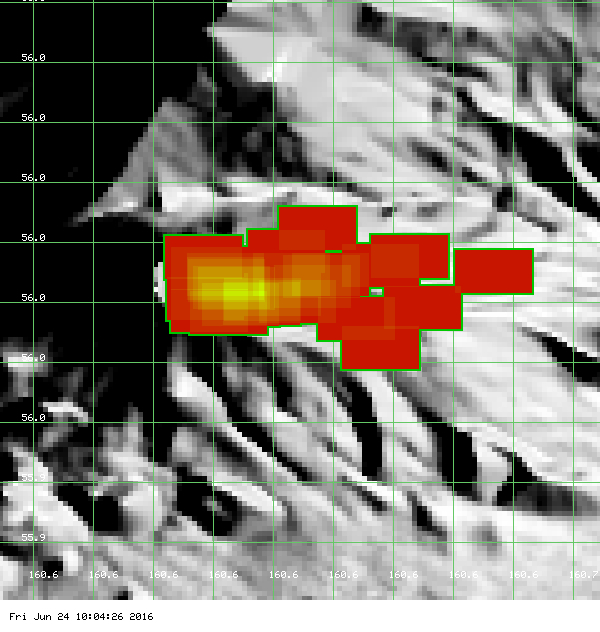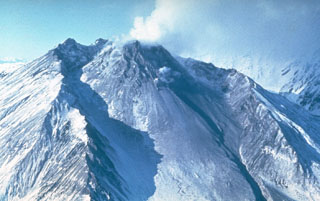Report on Bezymianny (Russia) — July 2015
Bulletin of the Global Volcanism Network, vol. 40, no. 7 (July 2015)
Managing Editor: Edward Venzke.
Research and preparation by Paul Berger.
Bezymianny (Russia) Lava flows and large explosion in early 2012; dome effusion through at least mid-August 2013
Please cite this report as:
Global Volcanism Program, 2015. Report on Bezymianny (Russia) (Venzke, E., ed.). Bulletin of the Global Volcanism Network, 40:7. Smithsonian Institution. https://doi.org/10.5479/si.GVP.BGVN201507-300250
Bezymianny
Russia
55.972°N, 160.595°E; summit elev. 2882 m
All times are local (unless otherwise noted)
Lava flows and several strong explosions at Bezymianny during early 2010 through September 2012 sent plumes as high as 10-12 km altitude (BGVN 37:08). Activity decreased afterwards, with weak-to-moderate fumarolic emissions and thermal anomalies through at least 2013. The data in this report came primarily from the Kamchatka Volcanic Eruptions Response Team (KVERT) weekly reports. Local time is UTC + 12 hours.
Thermal anomalies were recorded by MODVOLC between 19 February and 10 March 2012, and indicated lava flows descending the eastern slope (figure 16). Strong explosions 8-9 March had sent ash plumes to 3.5-5 km altitude, and ash plumes caused by pyroclastic flows went to 8 km altitude and drifted 700 km NE. Ash also fell 120 km ENE. Although there were no further explosions or MODVOLC alerts, KVERT continued to note through October that activity was moderate, with low seismicity, an effusing lava flow from the southern dome, fumarolic activity, and intermittent thermal anomalies seen in satellite data.
 |
Figure 16. MODVOLC thermal alert pixels during 19 February-10 March 2012. Courtesy of Hawai'i Institute of Geophysics and Planetology (HIGP), MODVOLC Thermal Alerts System. |
A large explosion on 2 September 2012 explosion sent ash plumes to an altitude of 10-12 km that drifted 1,500 km ENE. Afterwards, viscous lava continued to effuse on the lava dome flank, where collapse of the lava flow front caused hot avalanches through 4 October 2012.
Activity described as effusive by KVERT continued through 17 August 2013, usually also noting that the activity was on the lava dome flank, fumarolic activity, and sometimes thermal anomalies. KVERT terminology changed to noting "moderate" rather than "effusive" activity on 22 August, but the description of the volcanism remained otherwise similar through 2013, including ongoing weak thermal anomalies over the lava dome when cloud cover allowed for satellite observations.
Geological Summary. The modern Bezymianny, much smaller than its massive neighbors Kamen and Kliuchevskoi on the Kamchatka Peninsula, was formed about 4,700 years ago over a late-Pleistocene lava-dome complex and an edifice built about 11,000-7,000 years ago. Three periods of intensified activity have occurred during the past 3,000 years. The latest period, which was preceded by a 1,000-year quiescence, began with the dramatic 1955-56 eruption. This eruption, similar to that of St. Helens in 1980, produced a large open crater that was formed by collapse of the summit and an associated lateral blast. Subsequent episodic but ongoing lava-dome growth, accompanied by intermittent explosive activity and pyroclastic flows, has largely filled the 1956 crater.
Information Contacts: Kamchatka Volcanic Eruptions Response Team (KVERT), Far East Division, Russian Academy of Sciences, 9 Piip Blvd., Petropavlovsk-Kamchatsky, 683006, Russia (URL: http://www.kscnet.ru/ivs/); Hawai'i Institute of Geophysics and Planetology (HIGP), MODVOLC Thermal Alerts System, School of Ocean and Earth Science and Technology (SOEST), Univ. of Hawai'i, 2525 Correa Road, Honolulu, HI 96822, USA (URL: http://modis.higp.hawaii.edu/).

